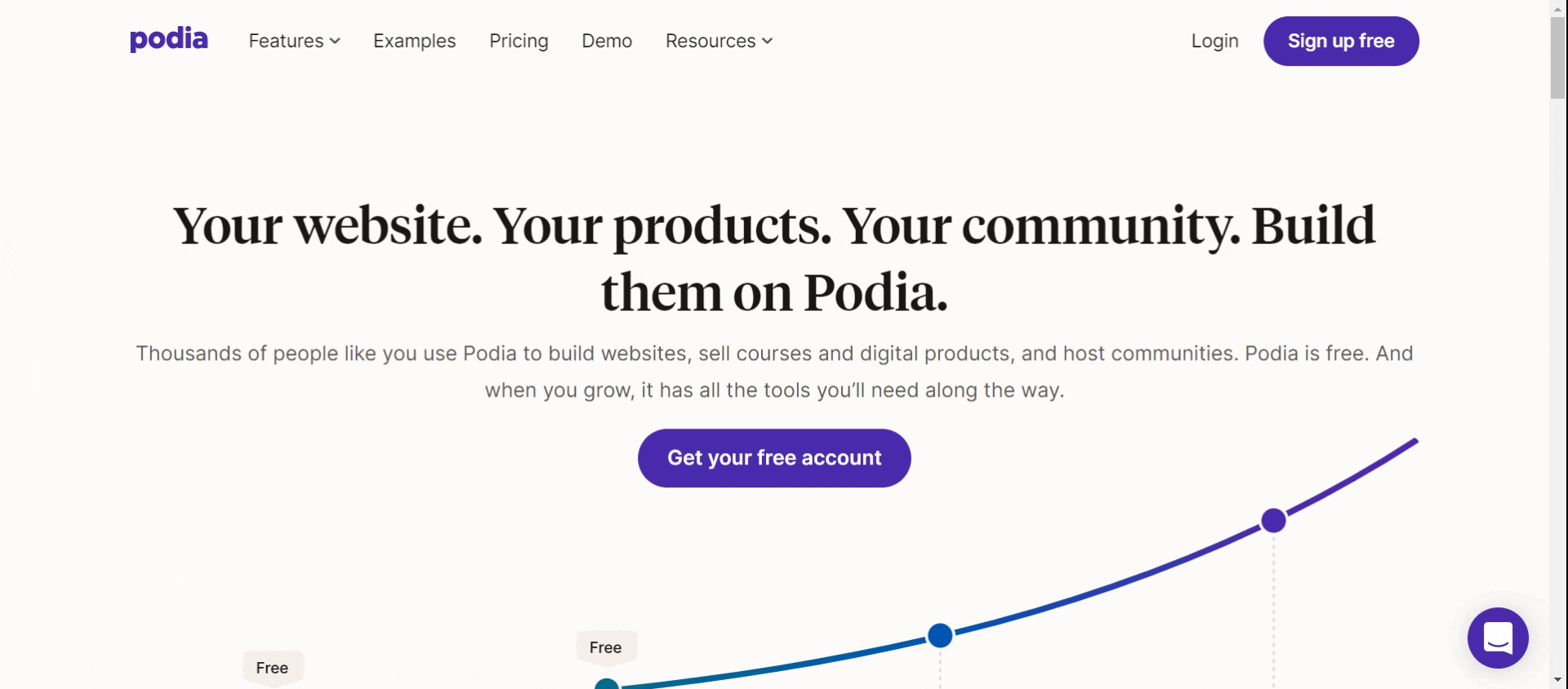- 1. Setting the Foundations for SaaS Content Marketing
- 2. Research for SaaS Content Marketing
- 3. Presenting the Offer the Right Way in SaaS Content Marketing
- 4. Creating a Content Strategy for Your SaaS
- 5. Executing the Content Strategy for Your SaaS
- 6. Bonus: Examples of SaaS Content Marketing to Inspire You
- Have More Questions About SaaS Content Marketing?
If you’re looking for a SaaS content marketing guide, you’re in the right place. I’ve been in the content marketing industry for over 7 years. During that time, I worked predominantly in B2B SaaS and had the opportunity to collaborate with amazing tech companies.
I was lucky enough to work with clients who truly understood the value of content marketing and had trust in me to guide them through everything.
Moreover, the majority of my clients were open to ideas that were a bit “out there”. It was sometimes challenging to tie a clear KPI to them, but they brought value long-term. That’s one of the most exciting things about SaaS content marketing: if you’re creative and daring enough, you can create content that covers multiple business goals simultaneously.
I’m writing this SaaS content marketing guide with the aim of offering you insights based on my experience. There are also a lot of visual summaries, illustrative examples, actionable steps, and pro tips that will make your life easier.
1. Setting the Foundations for SaaS Content Marketing
Let’s start with some hard pills to swallow. You cannot expect your SaaS content marketing activities to bring results if you don’t have the right marketing foundations.
Most marketers are impatient to get the ball rolling, especially in fast-paced startups. However, the prep work is what will ensure that the ball is at the right starting point and ends up rolling in the right direction.
Doing strategic brainstorming and reaching an internal consensus about your key differentiation points, mission, vision, and values might be a less exciting part of the process than hitting the publish button. But it is nonetheless essential.
I’ve developed a content strategy framework called the Adhesive Content Strategy™ that really simplifies how you should approach creating a content strategy for your SaaS. Below you can see the key phases:
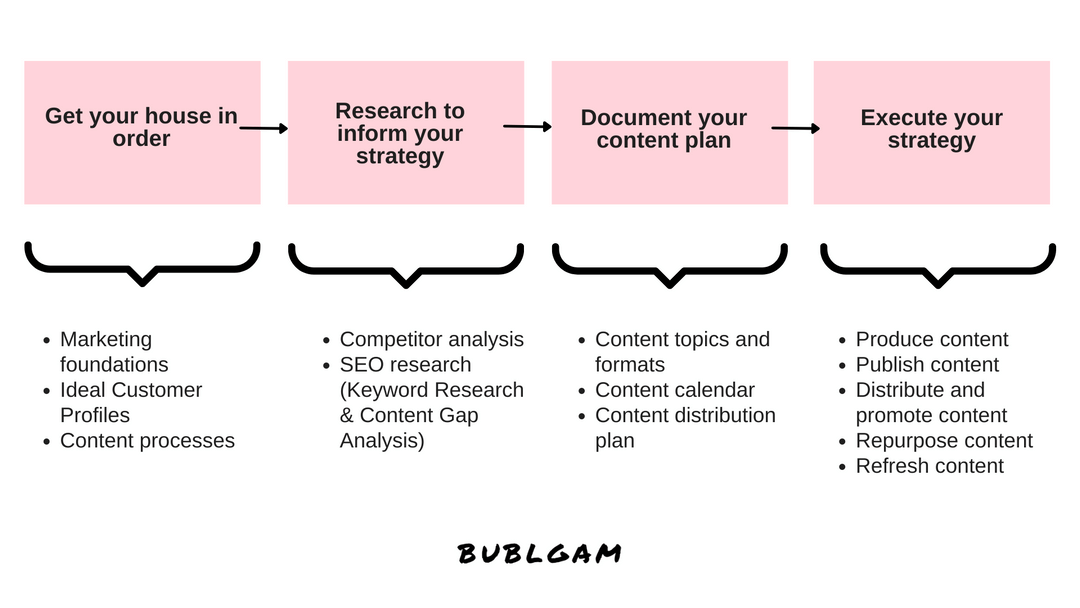
If you’re a SaaS marketer, you need to work with founders and/or CEOs to establish marketing foundations. In most cases, you’ll need to organize team brainstorming sessions and workshops, conduct extensive market research, do customer interviews, dive deep into data analysis, and more.
It’s all about asking smart questions, defining the most suitable methods to get answers, and then making assumptions you will test in reality by publishing content that supports your hypothesis.
1.1. SaaS Content Marketing Foundations
Setting marketing foundations implies finding answers to the following questions:
- What is our value proposition?
- What are our core values and what is the essence of our culture?
- What are the core messages we want to push?
- What is our brand identity?
Below you can find examples of questions that need to be answered comprehensively in order to build internal documentation and have a solid starting point for your content strategy.
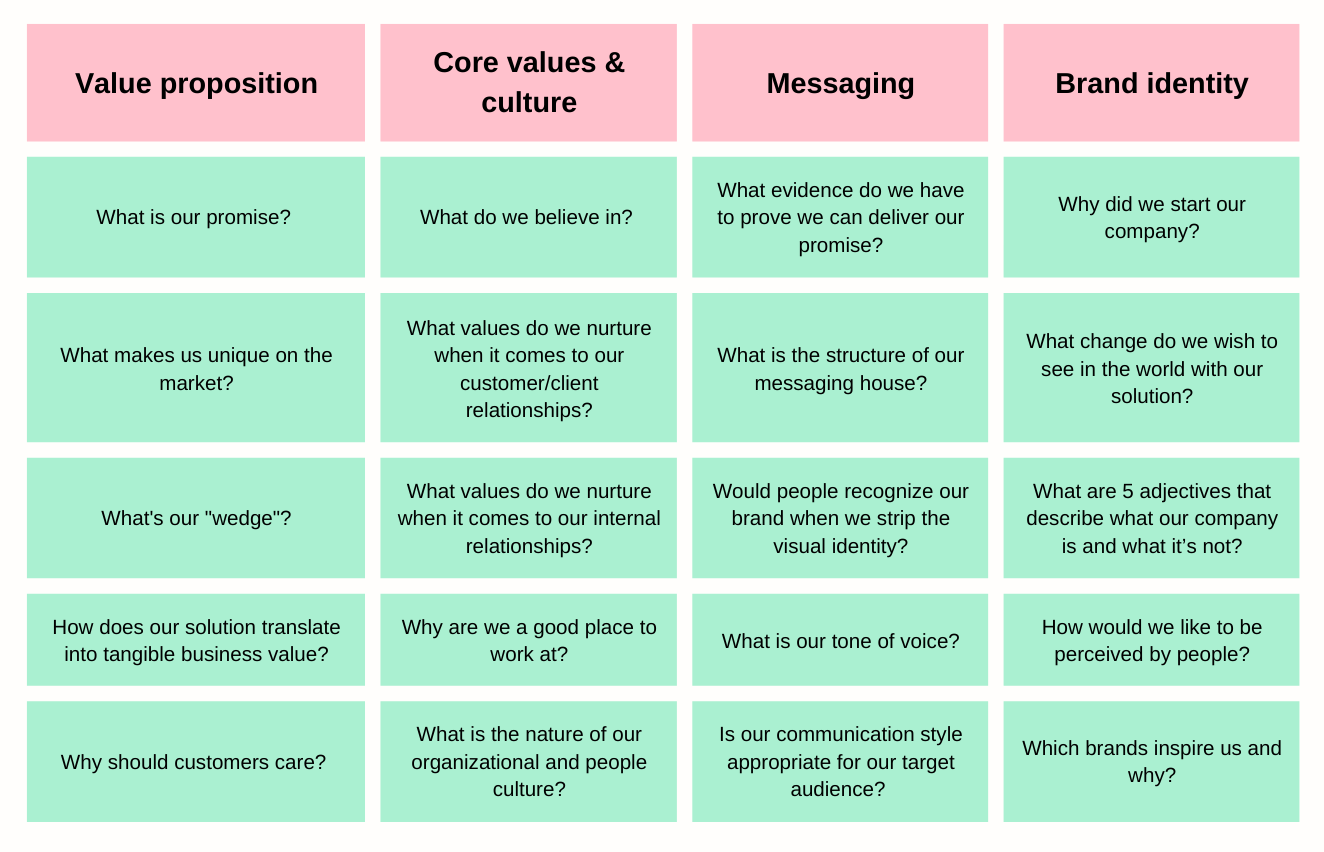
1.2. Tailoring Your SaaS Content Marketing to the Right People
Precisely knowing who you are trying to engage through content is the only way to achieve results. You should never try to cast a wide net in hope that some fish will get caught in it. It doesn’t work like that. Specificity is the key ingredient for a successful SaaS content strategy.
So before you start brainstorming topics for your SaaS blog and other marketing channels, you need to have detailed internal documentation about:
- Your Ideal Customer Profiles (ICP)
- Your target personas
Let’s take a look at both.
1.2.1. Ideal Customer Profiles (ICP)
Your ICPs are your best customers, i.e. those that you truly want to serve. What’s considered “the best” varies from each individual SaaS company. Here is a list of criteria you can use to determine what makes your ideal customers:
- Short sales cycle
- Higher account value
- Users who don’t take a ton of your experts’ time
- Long retention
- Cultural fit and great customer relationship that leads to recommendations
- Something else you find important internally
Here you can see the basic ICP information you should have:
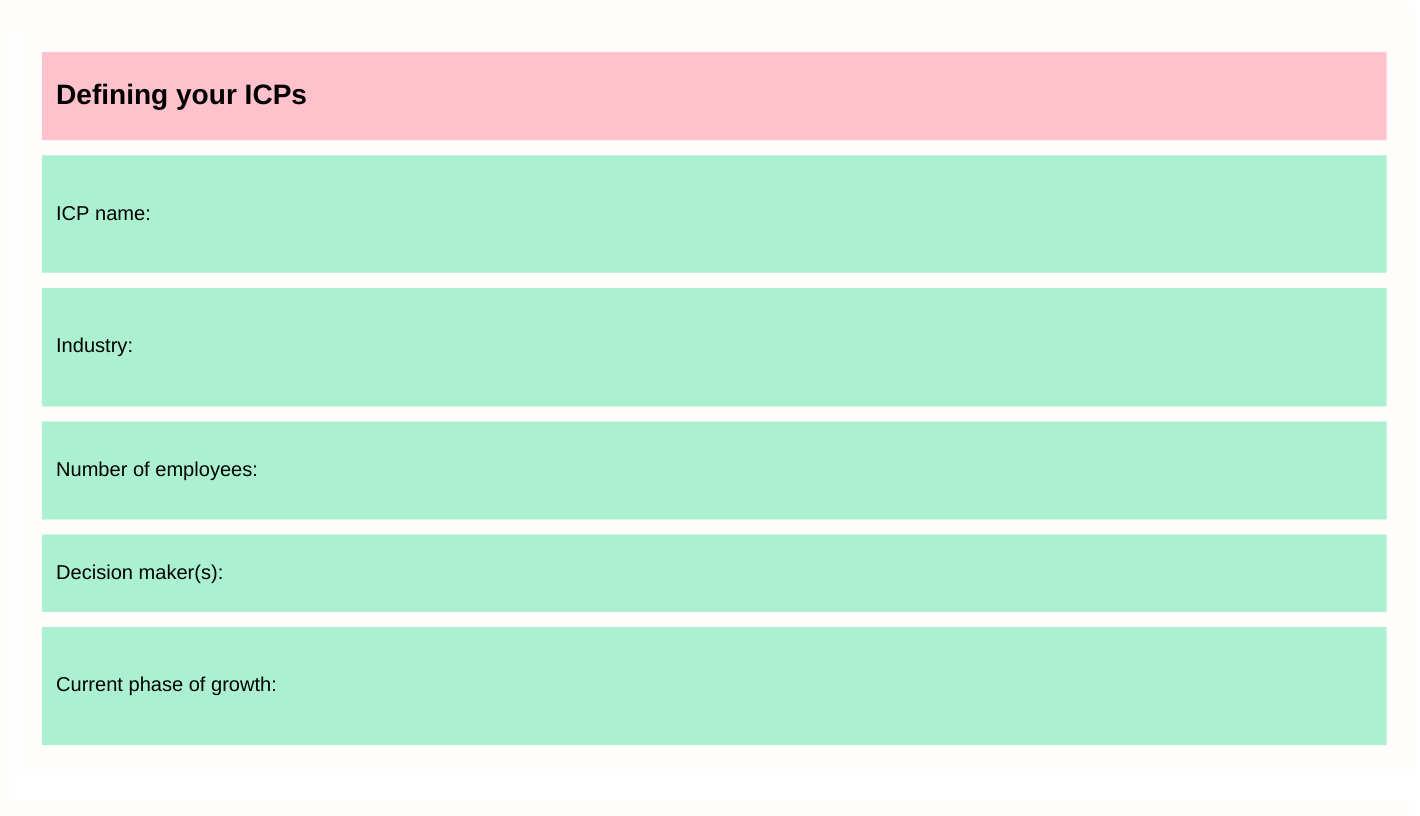
Here are all the insights you should gather, primarily through customer interviews.
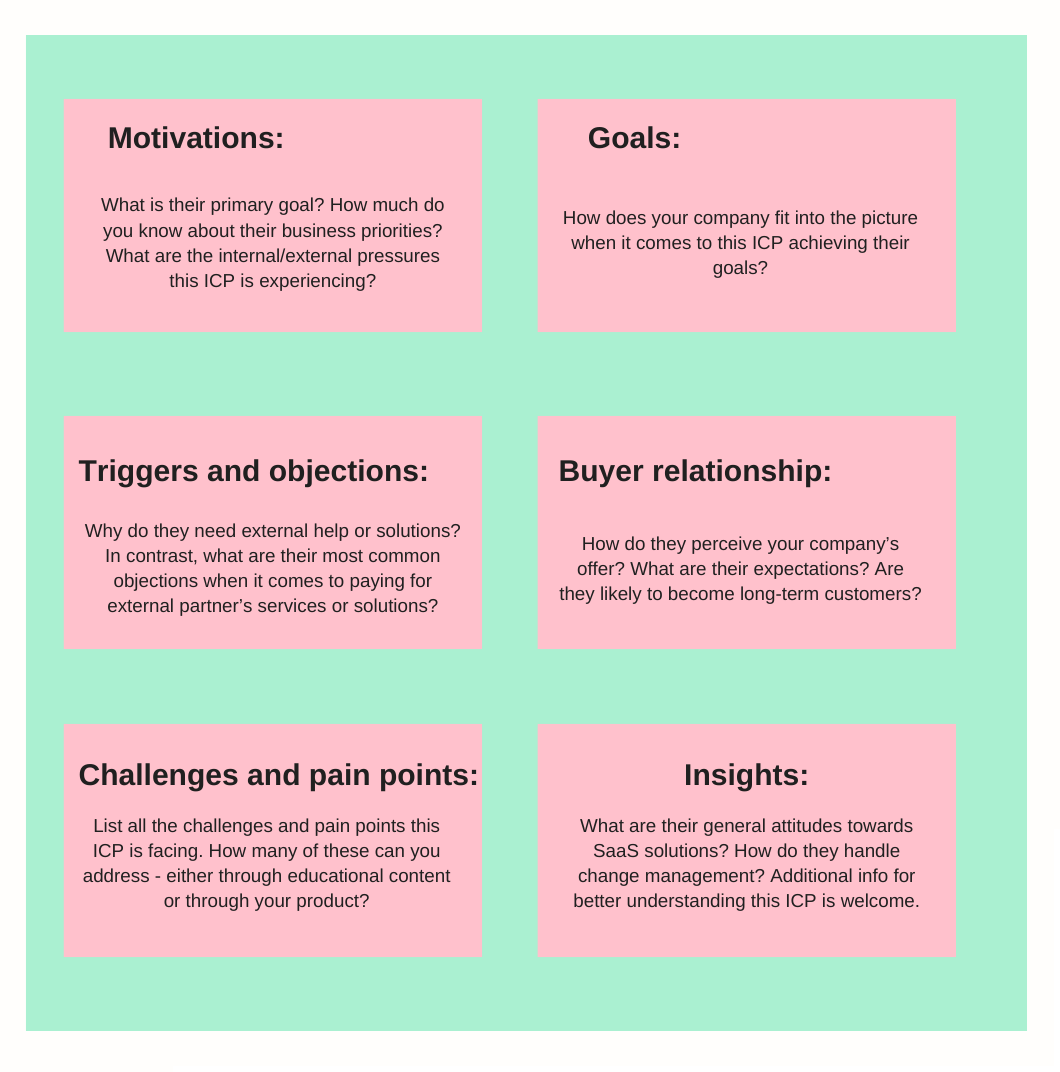
| [FREE TEMPLATE] Copy this ICP template to your Google Drive to make it easier for you and your team to describe your best customers. |
If you already have an established customer portfolio, it’s good to do some reverse-engineering and try to identify your ICP. Here are some of the questions that can help you out there:
- Which customers were the easiest for you to close? Why is that?
- What was the most common title of the person deciding that you have the best SaaS solution for them?
- How much do you know about your customers’ internal process of making the decision on whether or not they should buy your software?
Once you establish your ICPs, your sales and marketing teams can focus on getting this type of customer as opposed to the ones that you can serve.
Now let’s move on to personas.
1.2.2. Target Personas
I’ll be completely honest with you: I think that describing your personas with demographic data is almost always useless. In my opinion, if you want to go granular and humanize your prospects to make it easier to market and communicate with them, you should rely on a framework from design thinking—Empathy Mapping. It’s fairly easy to incorporate the “Job-to-be-done” framework with it as well.
In addition to listing your persona’s key responsibility and pain points, you should include an empathy map that can look something like this:
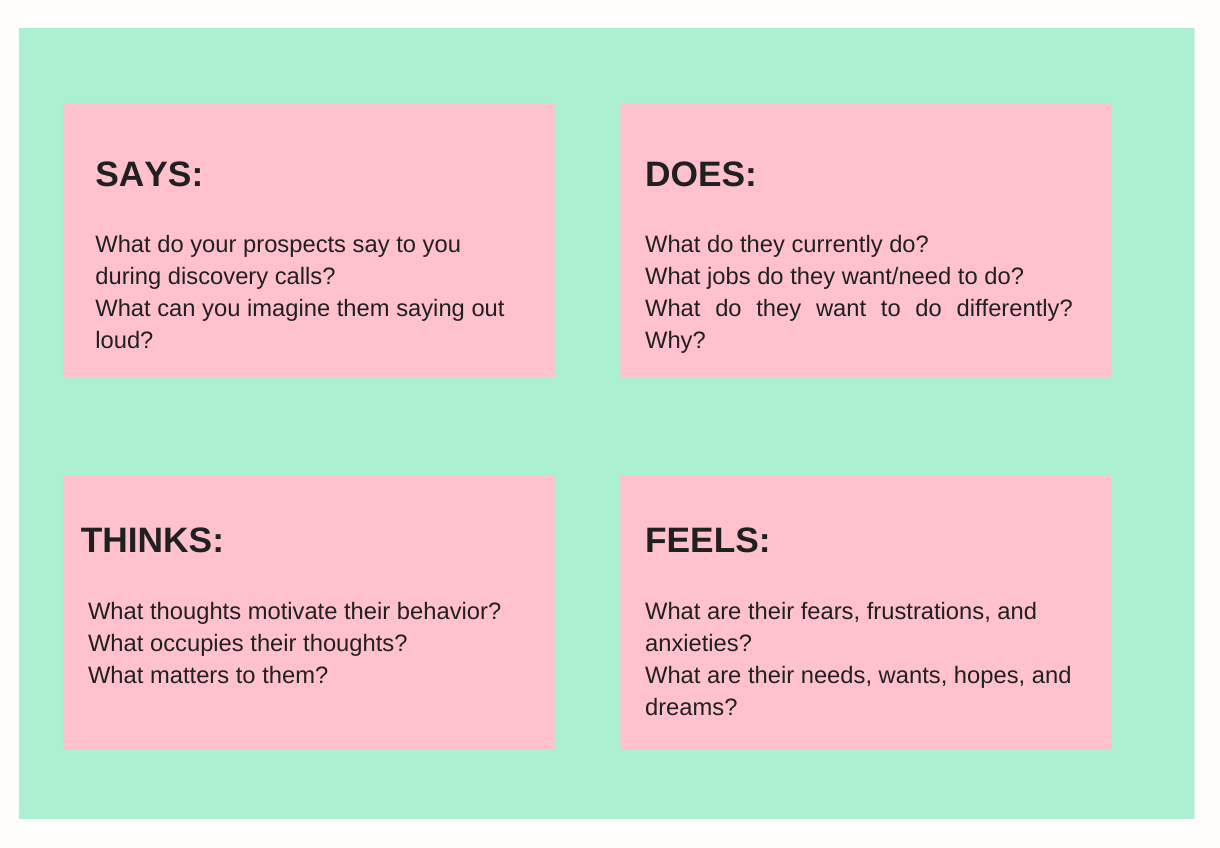
Here it’s of key importance not to mix your end users with key decision makers. Sometimes, these two groups overlap or it’s even the same person (which is mostly the case in B2C). However, in B2B, things are a bit more complicated. The sales cycle is longer and you have various stakeholders that participate in making the final call about the investment.
Here’s a real-life example of what happened in Content Insights, a content analytics company I used to work for. It was a mission-driven startup that wanted to help online newsrooms and journalists properly measure content engagement. The idea was to help them move from an ad-based business model to a subscription-based business model and preserve quality and honest journalism.
At first, the marketing team focused on its end users, journalists, and other content professionals. However, it wasn’t long before we realized that we need to market on multiple fronts and develop additional value propositions for other personas. Why? Well, because journalists didn’t have the buying power.
This doesn’t mean that we should have stopped marketing the software to them. On the contrary. It was crucial for our users to understand the value of our solution, and then advocate for it in-house. If you want them to succeed, you need to give them the right materials that would aid them in doing so.
This is why we worked on creating a compelling offer for the key decision makers, which meant we needed to develop new value propositions and quantify the business benefits the best we can. Again, it all starts with developing ICPs and personas. But it doesn’t mean you will never revisit this documentation. You’re likely to make mistakes and your product will evolve, which means that the market you’re going to effectively serve will change too.
2. Research for SaaS Content Marketing
Now that you have your marketing foundations in place, you need to do:
- SEO research (keyword research and content gap analysis)
- Competitor analysis
2.1. SEO Research for SaaS
There’re many different ways you can approach SEO research. I personally use Ahrefs, but SEMRush is also pretty good.
Of course, you should never prioritize SEO over your audience’s interest. However, there is a sweet spot somewhere in between and that’s where the golden content lies:
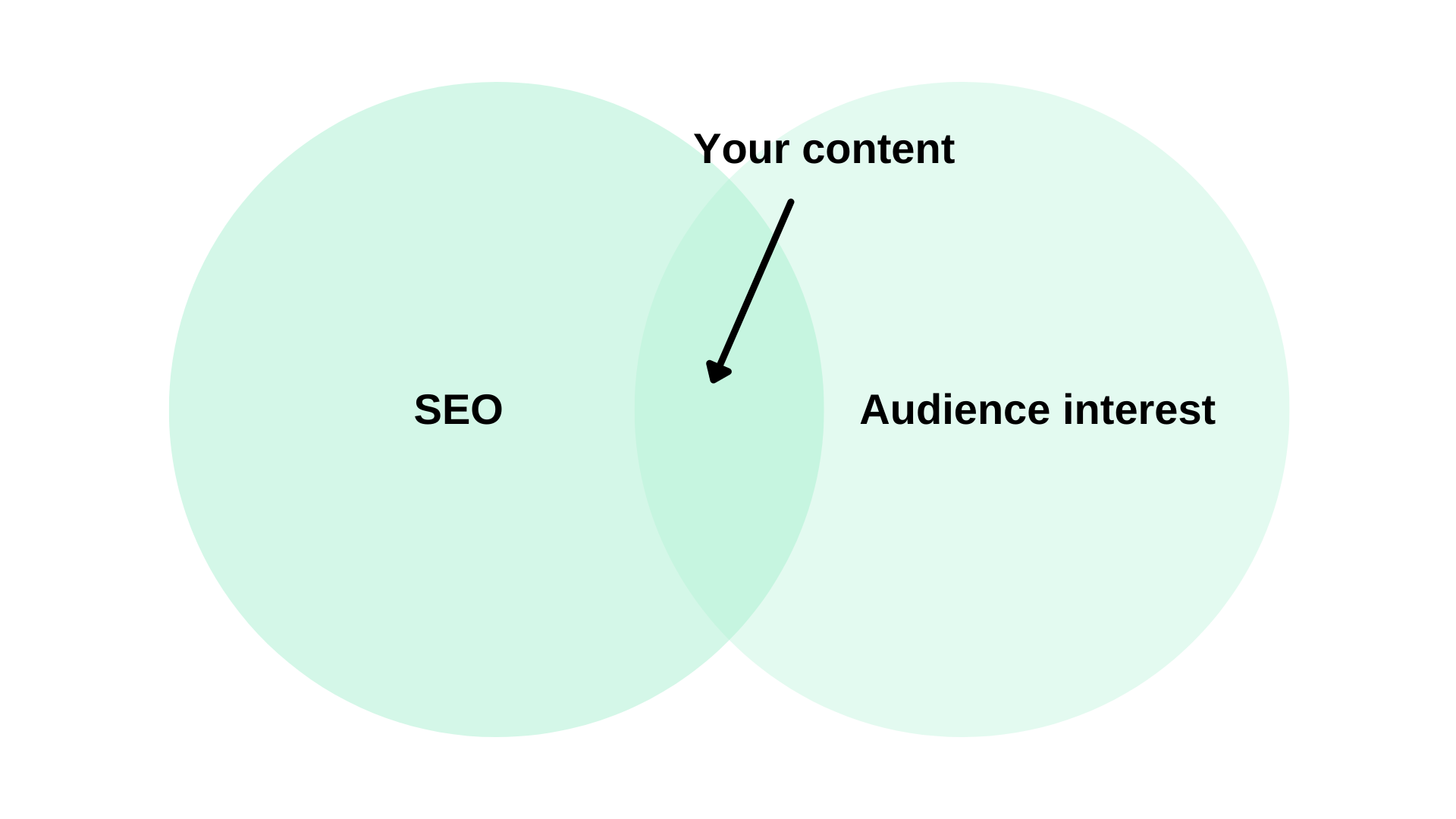
Important tips to remember about doing SEO research for SaaS:
| What | Why |
| If you’re working with a SaaS website that already has published content, first do an SEO and content audit. | If you’re already ranking for certain keywords, it might make more sense to create a content refresh plan and leverage the rankings you already have. Addressing these low-hanging fruits is typically smarter than creating new content from scratch. Plus, you wouldn’t want to cause keyword cannibalization. |
| Think twice before choosing a BOFU keyword to create a blog post. | If you identified a keyword that has a clear commercial intent, think about creating a separate landing page for it instead of a blog post. Not only will this informational architecture aid with ranking higher in SERP, but you will also improve content discoverability. |
| Don’t chase monthly search volume like a maniac. | The SEO tools we all rely upon give us just an estimate of the monthly search traffic a certain keyword phrase generates. Take this with a grain of salt. There are a lot of case studies that “zero volume keywords” actually bring a decent amount of traffic.
If you’re marketing for enterprise software, even if you get 1 deal from search this way is precious. |
If you’re wondering how to choose your keywords, here are some criteria I rely on:
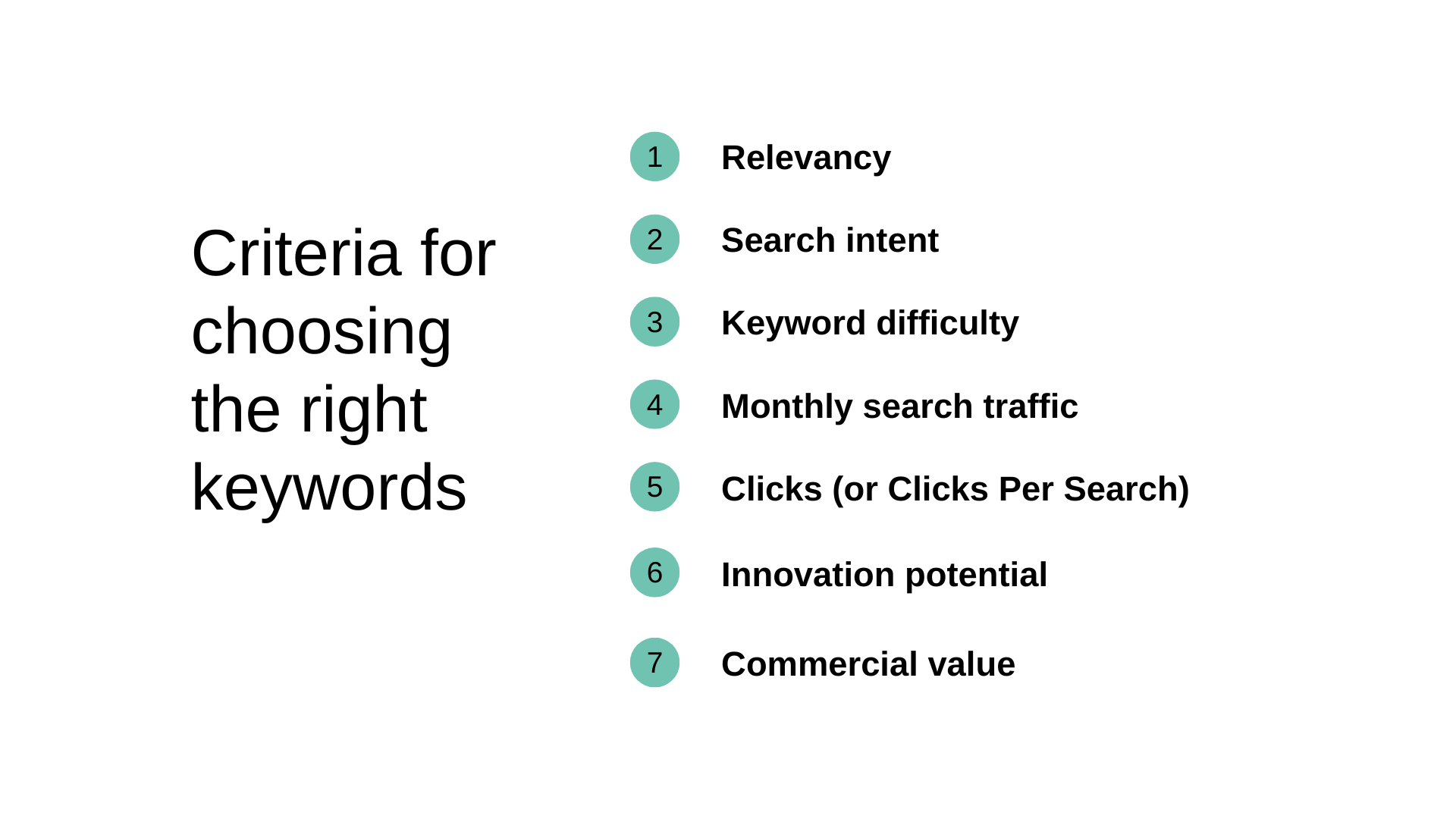
Pro tip: It makes sense to create content built upon the keyword phrases your prospects use to form queries, especially for the bottom-of-the-funnel keywords. Here’s a neat trick for how you can find new BOFU keyword opportunities in less than 3 minutes by doing a content gap analysis in Ahrefs:
Key takeaway: It’s very short-sighted to think you’ll get no value from building your presence in search or to perceive everything in such a binary way. Content and SEO are not a matter of “either-or”, they are complementary.
2.2. Competitor Analysis
Because content gap analysis is an integral part of the SEO research process, I start analyzing competitors right away.
Understanding what your competition is doing matters because you have to know what you’re up against. It’s not just about keeping an eye on the way they are handling SaaS content marketing, but it’s also about staying informed about their product roadmap and adjusting your own.
You can analyze your competitors in many different ways. The most used format is a simple Google Sheet you can easily update. If you have the resources, you can also build more thorough documentation about your competitors. Here are some of the ways I’ve been doing it for years:
3. Presenting the Offer the Right Way in SaaS Content Marketing
The way you organize information and structure your SaaS website will determine the level of understanding users will develop about your software. Your content and overall website experience combined with strategically positioned CTAs are key to increasing conversion rates.
Here are a few SaaS champions of different stature who I think are doing a phenomenal job in differentiating their product on the market. I’ll pick different brands to make a point of using your website real estate the best way.
3.1. Lokalise Brings Value to All Those Who Participate in the Localization Process
When I first joined Lokalise as a Content Marketing Lead back in 2020, I worked with the Head of Marketing to:
- Emphasize that the localization software is a robust solution and a collaborative platform that offers a lot to different types of users
- Ensure product features are well communicated on the website
- Figure out how we can build topical authority in search and have relevant landing pages for PPC campaigns
Let’s just focus on the first bullet because it’s incredibly important for SaaS content marketing.
When you open the Lokalise website, you can see “Solutions” in the main navigation. The drop-down menu then lists all the users that can benefit from using Lokalise. These are all clickable links that direct the website visitor to separate landing pages.
By doing so, you are enabling a website visitor to immediately identify with a certain persona and jump into the benefits your software brings to them. Each landing page is built on specific pain points that the persona experiences, which makes the content resonate with them.
3.2. Podia Gives Content Creators an Option to Get to Know the Product in Their Own Way
I never did marketing for Podia, but I am a Podia user. I think they have a truly great way to acquire new users and enable them to test the product. Namely, they covered all the possible demo scenarios which I think it’s brilliant.
When you land on the website, you can either sign up for free right away and use Podia without spending a dime. This is the most common way SaaS companies try to convert users to paying customers. But then, you can also click on “Demo” in the main navigation bar, and then you’ll encounter a landing page that gives you three options:
- Take a video tour of Podia
- Explore a real demo site
- Sign up for a live walkthrough demo
With the actual sign-up option, it amounts to a total of four different options you have to learn more about Podia before committing to pay. I don’t know what are their conversion rates, but I’m guessing they are pretty darn good.
3.3. Gong Creates a New Category and a Strong Narrative Around it
I’ve been a fan of Gong for years now. There’s so much you can learn from them. I’ve watched them raise funding (a total of $538 million so far), survived three of their rebrandings, and was incredibly inspired by their data articles, bold branding, and tone of voice. None of this was typical for one B2B SaaS brand.
But they did it. They also created a new category that started as Revenue Intelligence but is now called Reality Platform™. Their website tagline used to communicate the value of relying on data as opposed to opinions. After the final rebrand, it’s a bit changed, but the core message is still there: you need to be real and allow technology to tell you like it is. Data, not opinions.
Thanks to this very strong data-driven approach that permeates not only Gong’s company culture but also its content, Gong has become a well-respected thought leader in the sales industry. They even collaborate with the academic world.
Here, I really need to pause for a second. If you’re a SaaS startup, you might want to become another “category creator”. The truth is, there is only a handful of true category creators on the market and an awful bunch of those that rename existing concepts and products to position themselves as pioneers and “innovate”.
You can revolutionize your industry in million ways and it doesn’t have to be through a new category. You can also redefine a category or simply do a better job at marketing in general. You can focus on your brand and product experience, or hire kind and patient people for customer support. Not everyone can and should disrupt a market.
4. Creating a Content Strategy for Your SaaS
I’ve seen a lot of poorly crafted content strategies in my career. Given the fact that I work both for a marketing agency, as an in-house SaaS content marketing, and as a solopreneur serving clients, I can share valuable insights from different perspectives.
If you’re outsourcing your content strategy to an external agency, don’t let them serve you with just a list of keywords and blog topics. A strategy document is much more than that. The Adhesive Content Strategy™ I developed acts like a glue that holds all the essential elements of your SaaS content marketing together. Not only that, but it also mends the parts that need fixing.
The end result should be a comprehensive document that consists of many different parts of research and serves as a single source of truth for your content marketing team (but other teams as well).
When all of the eight elements are included, your content strategy document becomes a powerful manual for your team members. It is written in a way that is easily scannable, it has key summaries and is sectioned in segments that allow for quick answer discovery.
At any given moment, your team members can reference the document and remind themselves of the “why” behind each content piece.
Here are the main segments you should have inside your content strategy document:
| Segment | What is it |
| Overview | Summary of the content strategy (e.g. how many articles per week do you plan on publishing, an overview of main marketing channels, the timeline) |
| Important resources | Include all the possible links to other internal documents (e.g. mapped user journeys, keyword research, ICP documentation, personas, OKR document, quality standards, RACI matrix for the content team) |
| Strategy goals | List all business goals you want to achieve with your SaaS content strategy (e.g. increase the number of qualified leads, improve online visibility, build brand equity, grow a community) |
| Challenges & to-do’s | List all the challenges you mapped out so far and the countermeasures you’d like to deploy (e.g. not enough resources, poor content distribution so far) |
| Target audience | Include a visual summary of all the personas you identified |
| Target markets & industries | List markets and industries you’d like to focus on (if there is an overarching business strategy to expand internationally, you can even launch integrated marketing campaigns) |
| Overall approach | Explain how many content categories would you like to focus on, what type of content formats, publishing frequency, etc. |
| Content category/lane | Explain which content categories you want to pursue and how well they are balanced when compared to the business goals (e.g. thought leadership content, conversion-focused content, case studies) |
| Content distribution plan | Create a content repurposing plan and list all the marketing channels and tactics you think the company should focus on (e.g. LinkedIn, G2, Twitter; link building, guest posting, partnership program, PR) |
| KPIs | Explain the key metrics you’ll use to measure the success of your strategy. |
4.1. Coming Up with Topics
Once you have your SaaS content strategy in place, it’s time to come up with the actual topics for the blog articles and other content formats. If you’re just getting started with setting up the blog and want to leverage SEO as much as possible, I would strongly recommend creating Hub & Spokes and focusing on building topical authority.
Think about the entire funnel (or a flywheel, if you prefer): from the first touchpoint when a person discovers your brand all the way to them making a purchase and recommending you to others.
Then try to identify at least three umbrella topics where you want to build credibility. You already have a huge chunk of this work finalized (well at least 50-60% of it) given the fact you finished keyword research in the second phase. And because you have your content lanes defined, it makes it easier to define the topics.
Pro tip: Always start brainstorming topics by reading through the pain points of your personas.
4.2. Creating a Content Calendar
Once you have your topics, it’s time to create a content calendar. You can use Notion, Airtable, or some other productivity tool. For calendars, I like to keep it simple: just a regular Google Sheet document does the trick.
In my experience, it makes sense to create a calendar for 3-6 months, depending on your publishing frequency and resources. Anything beyond that is not wise because you need to measure results and fine-tune your approach along the way. Also, it makes sense to set quarterly goals and have a separate OKR document for your content marketing team.
5. Executing the Content Strategy for Your SaaS
To ensure the success of your SaaS content marketing strategy, you need to have properly mapped procedures and a system that allows each team member to understand their responsibilities. Clearly communicating ownership is very important, especially if your SaaS company followed a hiring strategy that implied onboarding specialists.
Sometimes, the jobs of a product marketer, growth professional, and a content specialist might overlap, which is why it matters to divide ownership and discuss who’s to be held accountable for what. You also need to have mapped out dependencies.
| [FREE TEMPLATE] Not sure how to manage a high-performing SaaS marketing team? Feel free to copy my template of the RACI matrix for content teams. |
6. Bonus: Examples of SaaS Content Marketing to Inspire You
Lastly, I’d like to share with you a few SaaS content marketing examples that can help you come up with your own topics or campaigns. I’ll reverse-engineer what’s been done here and explain the value of the approach.
6.1. Lokalise: The Magic of Figma
In 2021, I wrote an article about the unusual use cases of Figma as a design tool. The article was a part of the campaign focusing on promoting design-led localization. I’ve managed to collect insights from designers working at LinkedIn, Netflix, King, and Bumble.
So, what was the impact? Because of its quality and the fact it collected interesting artwork created in Figma, the article became very popular after it got published. It got shared on LinkedIn by Netflix’s Product Design Lead and then Figma itself.
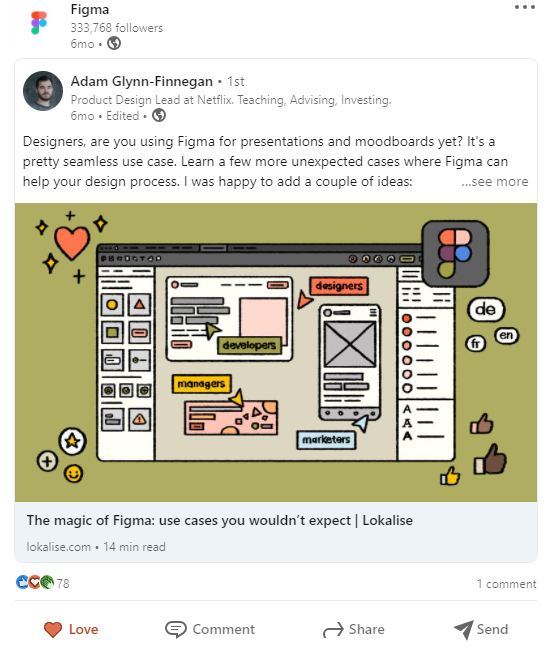
This ensured great exposure for Lokalise. The article became the most read piece on the website. Over 20k people read the article in the first week of publication. Although it’s challenging to put your finger on it and quantify how much did the article contribute to brand visibility, it was still a smart shot to take.
6.2. Content Insights: Moving Past Pageviews
While I was working on marketing the content analytics tool Content Insights (now smartocto), we experienced a significant “aha” moment within the team. We had internal documentation about competitors (battle cards that included feature comparison and whatnot), but we haven’t given much thought to our silent killer: Google Analytics.
Google Analytics is a free analytics tool but nonetheless—we also competed with it. GA measures browser events, not the reader’s engagement on a level that would be meaningful to journalists. There were a lot of technicalities in terms of metrics I personally didn’t know about GA, so I rolled my sleeves and read everything I could.
The result was a huge guide about the necessity of a more advanced way to measure content performance published in the State of Digital Publishing. We decided to pitch the idea to the editor because we knew that it would stir things up a bit in the industry, which it did. We challenged the idea of using only GA and offered a better alternative: use it complementary to Content Insights to get more precise insights.
6.3. Plainly: Quantifying Business Benefits of Creative Production Automation
I’m friends with one of Plainly’s co-founders, and he’s wholeheartedly invested in the no-code movement and video automation. They’ve recently published an article about creative production automation and how it can help you save up to 85% of your time.
Here’s why this article is great:
- It quantifies the business benefit through time savings
- It explains the possible use cases of creative automation
- It provides actionable tips while subtly positioning Plainly as a go-to solution
- It communicates the co-founder’s passion for the product (he shares his own experiment with creating the automation workflow)
- It has social proof and speaks about the product but aims primarily to educate and engage the reader
Have More Questions About SaaS Content Marketing?
Let’s be real: it’s not possible to cover everything about SaaS content marketing in a single article, no matter how comprehensive it is. However, I’ll be more than happy to share additional tips if you’re facing a particular challenge.
Read More:
- Local Business Content Marketing Guide
- eCommerce Content Marketing Guide: Gaining Online Sales With Content
- Email Content Marketing Guide: Why You Need to Try This Strategy
- SaaS Content Marketing Guide - October 5, 2022



